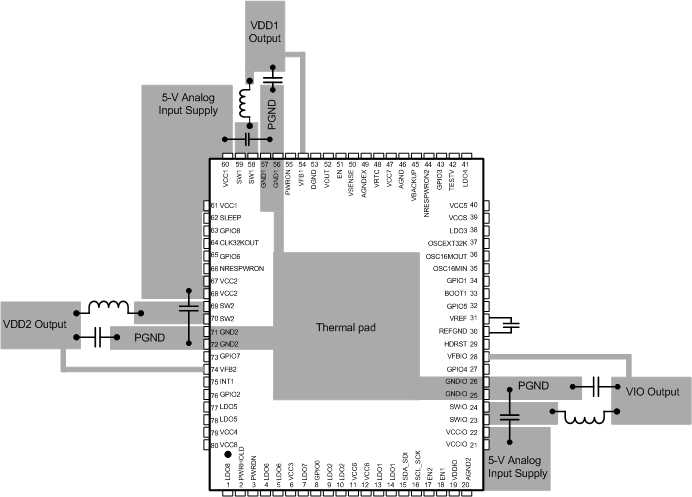SWCS106F March 2013 – July 2016 TPS659119-Q1
PRODUCTION DATA.
- 1 Features
- 2 Applications
- 3 Description
- 4 Revision History
- 5 Description (continued)
- 6 Pin Configuration and Functions
-
7 Specifications
- 7.1 Absolute Maximum Ratings
- 7.2 ESD Ratings
- 7.3 Recommended Operating Conditions
- 7.4 Thermal Characteristics
- 7.5 External Component Recommendation
- 7.6 I/O Pullup and Pulldown Characteristics
- 7.7 Digital I/O Voltage Electrical Characteristics
- 7.8 I2C Interface and Control Signals
- 7.9 Switching Characteristics—I2C Interface and Control Signals
- 7.10 Power Consumption
- 7.11 Power References and Thresholds
- 7.12 Thermal Monitoring and Shutdown
- 7.13 32-kHz RTC Clock
- 7.14 VRTC LDO
- 7.15 VIO SMPS
- 7.16 VDD1 SMPS
- 7.17 VDD2 SMPS
- 7.18 EXTCTRL
- 7.19 LDO1 AND LDO2
- 7.20 LDO3 and LDO4
- 7.21 LDO5
- 7.22 LDO6 and LDO7
- 7.23 LDO8
- 7.24 Timing Requirements for Boot Sequence Example
- 7.25 Power Control Timing Requirements
- 7.26 Device SLEEP State Control Timing Requirements
- 7.27 Supplies State Control Through EN1 and EN2 Timing Characteristics
- 7.28 VDD1 Supply Voltage Control Through EN1 Timing Requirements
- 7.29 Typical Characteristics
- 8 Detailed Description
- 9 Application and Implementation
- 10Power Supply Recommendations
- 11Layout
- 12Device and Documentation Support
- 13Mechanical, Packaging, and Orderable Information
Package Options
Mechanical Data (Package|Pins)
- PFP|80
Thermal pad, mechanical data (Package|Pins)
- PFP|80
Orderable Information
11 Layout
11.1 Layout Guidelines
As in every switch-mode-supply design, general layout rules apply.
- Use a solid ground plane for power ground (PGND).
- Use an independent ground for logic, LDOs, and analog (AGND).
- Connect those grounds at a star point ideally underneath the IC.
- Place the input capacitors as close as possible to the input pins of the IC.
- Place the inductor and output capacitor as close as possible to the phase node (or switch node) of the IC
- Keep the loop area formed by the phase node, inductor, output capacitor, and PGND as small as possible.
- For traces and vias on power lines, keep inductance and resistance as low as possible by using wide traces and plane shapes. Avoid switching layers, but if needed, use plenty of vias.
NOTE
This guideline is the most important and is more important than the output loop.
The goal of the previously listed guidelines is a layout that minimizes emissions, maximizes EMI immunity, and maintains a safe operating area of the IC.
To minimize the spiking at the phase node for both the high-side (VIN – SWx) as well as the low-side (SWx – PGND), the decoupling of VIN is critical. Appropriate decoupling and thorough layout practices should ensure that the spikes never exceed the absolute maximum rating of the respective pin.
11.2 Layout Example
 Figure 32. TPS659119-Q1 Layout Example
Figure 32. TPS659119-Q1 Layout Example